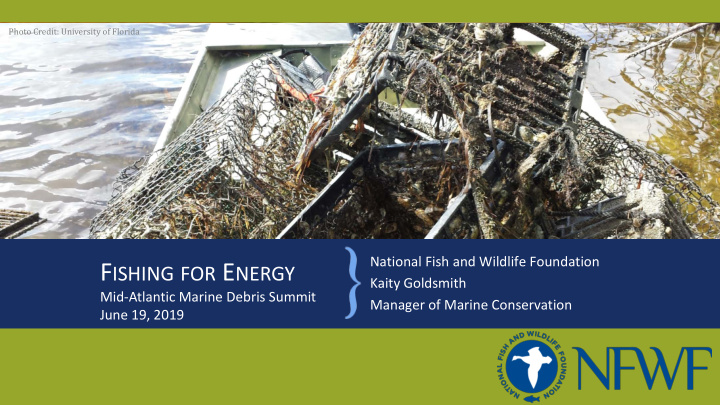



Photo Credit: University of Florida National Fish and Wildlife Foundation F ISHING FOR E NERGY } Kaity Goldsmith Mid-Atlantic Marine Debris Summit Manager of Marine Conservation June 19, 2019
F ISHING FOR E NERGY AGENDA • Overview of NFWF • Overview of Program • 2019 FfE Grant Program Priorities Photo Credit: Stellwagen Alive! Friends for our National Marine Sanctuary
N ATIONAL F ISH AND W ILDLIFE F OUNDATION • Created by U.S. Congress in 1984 • Independent, 501(c)(3) non-profit • No advocacy, lobbying, litigation • Public/Private partnerships – Federal agencies, corporations, and private foundations • Focus on conservation outcomes Photo Credit: Provincetown Center for Coastal Studies, Inc.
F ISHING FOR E NERGY Our Strategy Strategic initiative to reduce the amount and impact of derelict commercial fishing gear (DFG) • Proper DISPOSAL of Old and Unusable Gear • Derelict Gear REMOVAL • Technological INNOVATION • Community AWARENESS
F ISHING FOR E NERGY Overview of the Bin Program
F ISHING FOR E NERGY Overview of Grant Program • Collaboration with MANAGERS • Gear REMOVAL to restore habitat • Proper gear DISPOSAL • Identify & Test INNOVATIVE TECHNOLOGY • Public OUTREACH & EDUCATION
F ISHING FOR E NERGY Grant Program– Site Based Grants will target areas in U.S. coastal waters that have identified and prioritized derelict fishing gear reduction in state or regional plans, such as state marine debris action plans. Prioritize the ‘whole package’ Photo Credit: Smithsonian Conservation Biology Institute
F ISHING FOR E NERGY • Geographic Focus 2019 • Gulf of Maine • Chesapeake Bay • Puget Sound • Papahānaumokuākea Marine National Monument Photo Credit: Smithsonian Conservation Biology Institute
F ISHING FOR E NERGY – S ITE S ELECTION For removal projects • Reference state or regional plans that identify site as a priority • Identify gear accumulation prior to removal • Conservation benefit to sea turtles, marine mammals, commercial species, and coral reefs For innovation projects • Identify gear interaction concerns Photo Credit: College of William and Mary, Virginia Institute of Marine Science • Identify the effect on the fishery/wildlife • Indicate ‘point of loss’ to be addressed
F ISHING FOR E NERGY – M ETHODS AND A CTIVITIES For removal projects • Clearly explain methods for removal, best practices that will be used to minimize impact to existing habitat, status of any necessary permits and the composition and experience of the removal team • Please note any specific engagement of fishermen or veterans in removal efforts For innovation projects Photo Credit: Provincetown Center • New innovations can propose prototype for Coastal Studies, Inc. design and testing • On-boarding and adoption of already tested innovations
F ISHING FOR E NERGY - D ISPOSAL • Proposals must include anticipated recycling costs and logistics • Typical costs include: • Bin Rental • Haul • Tipping Fee • If you are proposing to work with a Fishing for Energy partner for recycling then you just need to get Photo Credit: Provincetown Center for Coastal Studies, Inc. the hauling quote from the hauler and any rental fees • MUST plan for security
F ISHING FOR E NERGY - M ANAGEMENT C ONNECTION • Tie the direct conservation activity of derelict gear removal of target fishery for innovation to broader impact around marine debris in the state or region. • Address source, point of loss, rate of loss/accumulation, rate of decay, calculated impact to wildlife, bycatch rates, etc. • Letter of support from relevant agency required Photo Credit: Regents of the University of California - Davis
F ISHING FOR E NERGY - O UTREACH • Raise awareness around the effort and the findings of the project and where appropriate, engage the local public and fishing communities • Partnerships with nearby public education venues are strongly encouraged Photo Credit: The Bay Institute Photo Credit: Smithsonian Institution
T IPS T O C ONSIDER … • Don’t make reviewers work too hard. • Show clear links between the goals/plan and activities. • Be specific, be quantitative when possible. • Reference models, past experience or outside expertise that will lead to successful implementation. • State the hurdles/challenges and how you will address them to reduce risk. • Demonstrate how the outcomes of your project will be sustainable. • Have realistic goals and show how you will measure them or progress to them within the Period of Performance. • Remember – NFWF is conservation impact focused!
F ISHING F OR E NERGY Engaging People in Conservation https://www.nfwf.org/fishingforenergy Contact Information: Kaity Goldsmith Manager, Marine Conservation Kaitlin.Goldsmith@NFWF.ORG QUESTIONS?
Recommend
More recommend